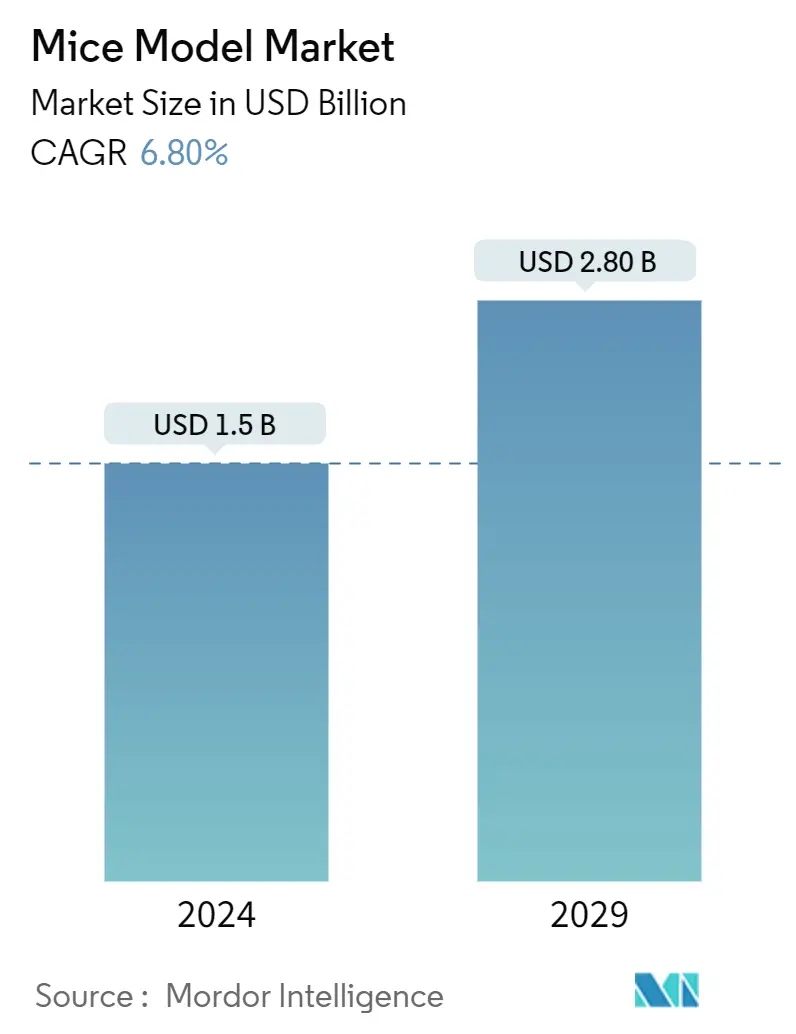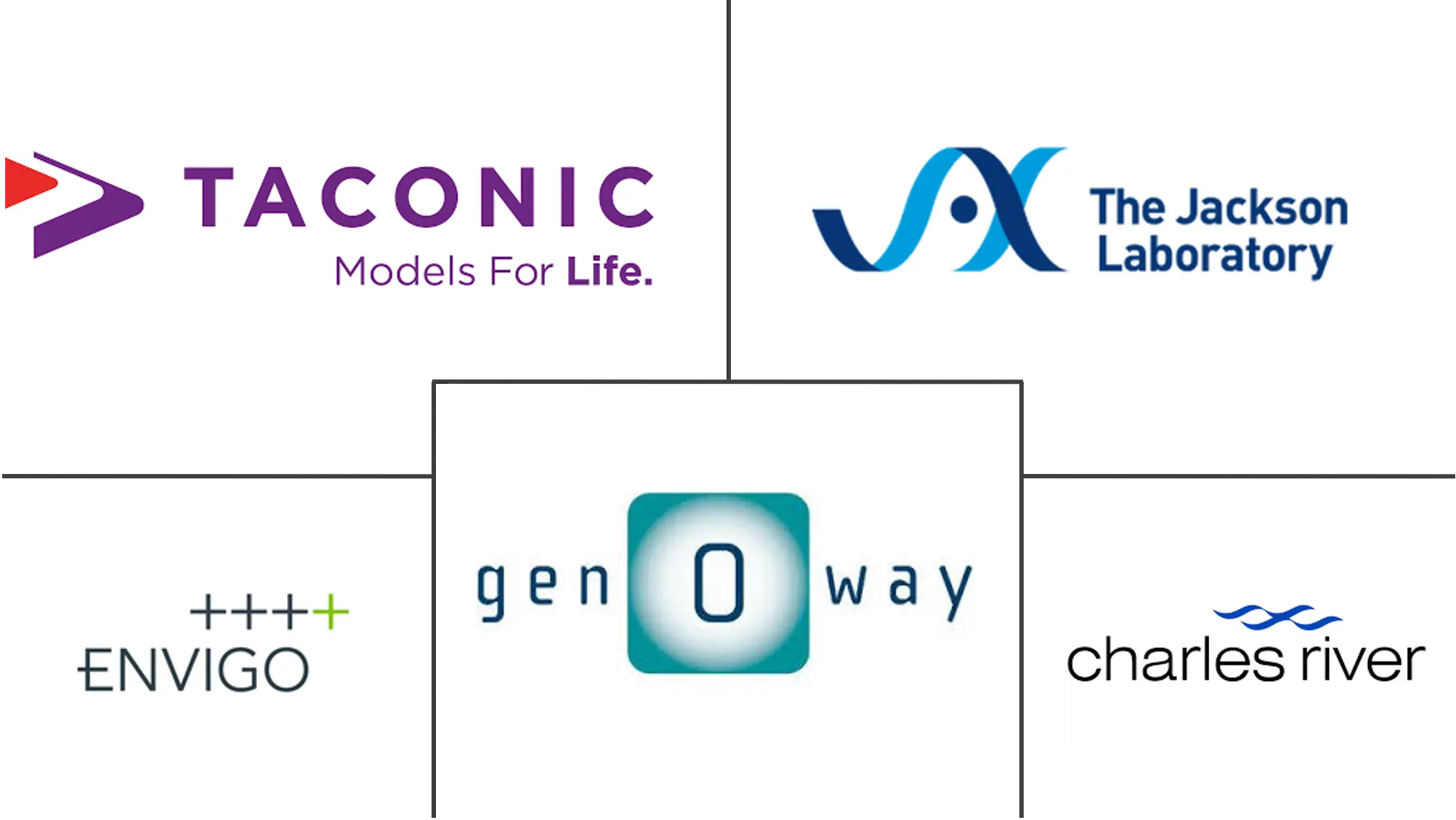Market Size of Mice Model Industry

| Study Period | 2019 - 2029 |
| Market Size (2024) | USD 1.5 Billion |
| Market Size (2029) | USD 2.80 Billion |
| CAGR (2024 - 2029) | 6.80 % |
| Fastest Growing Market | Asia Pacific |
| Largest Market | North America |
Major Players
*Disclaimer: Major Players sorted in no particular order |
Mice Model Market Analysis
The Mice Model Market size is estimated at USD 1.5 billion in 2024, and is expected to reach USD 2.80 billion by 2029, growing at a CAGR of 6.80% during the forecast period (2024-2029).
The mice model market is expected to register a CAGR of 6.8% over the forecast period. The COVID-19 pandemic had a significant impact on the market studied. Research laboratories and biopharmaceutical industries extensively used mice models in preclinical development. For instance, according to an article published by Methods of Molecular Biology in October 2022, a small rodent animal model using K18 hACE2 transgenic mice was presented as an option for understanding the pathogenicity of natural SARS-CoV-2 strains. Thus, the adoption of mouse models to analyze the progress made since the discovery of SARS-CoV-2 in developing and applying relevant mouse models had been anticipated to drive market growth during the pandemic. However, as the COVID-19 cases started to decline, the market had begun to show average pre-pandemic level growth and was likely to continue its significant growth rate during the forecast period.
Factors such as increasing innovations in mice models, rising demand for personalized medicine, and a growing pipeline of pharmaceutical and biopharmaceutical companies are driving the growth of the mice model market. For instance, an article published by Molecular Neurodegeneration in June 2022 stated that the genetic engineering of novel mouse models using knock-in approaches addresses some of the limitations of genetic mutations. Also, the article mentioned in its conclusion that the scientific community should use the open-access mouse model as a resource to study disease-relevant biology. Thus, such instances are anticipated to boost the demand for mice models, further driving the market growth.
In addition, the rising demand for precision medicine is driving the growth. For instance, in April 2022, an article published in the journal Nature Medicine reported that the increasing use of genomic profiling for diagnosis and therapy guidance in many tumor types had increased the use of precision medicine in cancer patients. With the increased demand for precision medicine, the utilization of mouse models will also increase, leading to market growth.
Furthermore, several key market players have also been investing in the market's growth. For instance, in January 2022, Inotiv acquired Orient BioResource Center, Inc. from Orient Bio, Inc., a preclinical CRO and animal model supplier based in Seongnam, South Korea. Orient BioResource Center is a primate quarantine & holding facility located near Alice, Texas.
Hence, as per the abovementioned factors, the mice model market is anticipated to grow over the forecast period. However, alternatives to animal testing and regulations for the ethical use of animals are expected to restrain the market's growth.
Mice Model Industry Segmentation
Mice models are biological representations of human diseases or syndromes. Mice and humans have approximately 99% similarity in their DNA. By studying mice that have symptoms of diseases like Alzheimer's, diabetes, or cancer, we can learn a lot more about how these diseases might be treated in patients.
The mice model market is segmented by type (inbred mice, outbred mice, genetically engineered mice, hybrid mice, surgically modified mice, and spontaneous mutant mice), service (breeding, cryopreservation, model in-licensing, genetic testing, and other services), technology (CRISPR/CAS9, embryonic stem cell injection, nuclear transfer, and other technologies), application (oncology, cardiovascular studies, neurology, and other applications), and geography (North America, Europe, Asia-Pacific, Middle East and Africa, and South America). The market report also covers the estimated market sizes and trends for 17 different countries across major regions globally.
The report offers the value (in USD) for the above segments.
| By Type | |
| Inbred Mice | |
| Outbred Mice | |
| Genetically Engineered Mice | |
| Hybrid/Congenic Mice | |
| Other Types |
| By Service | |
| Breeding | |
| Cryopreservation | |
| Model in-Licensing | |
| Genetic Testing | |
| Other Services |
| By Technology | |
| CRISPR/CAS9 | |
| Embryonic Stem Cell Injection | |
| Nuclear Transfer | |
| Other Technologies |
| By Application | |
| Oncology | |
| Cardiovascular Studies | |
| Neurology | |
| Other Applications |
| Geography | ||||||||
| ||||||||
| ||||||||
| ||||||||
| ||||||||
|
Mice Model Market Size Summary
The mice model market is poised for significant growth over the forecast period, driven by increasing innovations and the rising demand for personalized medicine. The market's expansion is supported by the growing pipeline of pharmaceutical and biopharmaceutical companies, which are increasingly utilizing mice models for preclinical development. The COVID-19 pandemic initially boosted the market as mice models were extensively used to understand the pathogenicity of SARS-CoV-2 strains. However, as the pandemic's impact waned, the market returned to its pre-pandemic growth trajectory. The adoption of advanced genetic engineering techniques, such as knock-in approaches, has further enhanced the utility of mice models in studying disease-relevant biology, thereby fueling market demand.
North America is expected to be a key region for market growth, attributed to increased healthcare expenditure and robust research and development activities. The region's market players are actively engaging in collaborations and agreements to advance mice model research. The oncology segment, in particular, is witnessing growth due to the rising burden of cancer and the adoption of mice models in drug and vaccine development. Product launches by key market players, such as Taconic Biosciences, are also contributing to market expansion. Despite the promising growth prospects, the market faces challenges from alternatives to animal testing and ethical regulations governing animal use. The competitive landscape is moderately concentrated, with several international and regional companies holding significant market shares.
Mice Model Market Size - Table of Contents
-
1. MARKET DYNAMICS
-
1.1 Market Overview
-
1.2 Market Drivers
-
1.2.1 Increasing Innovation in Mice Models
-
1.2.2 Rising Demand for Personalized Medicine
-
1.2.3 Growing Pipeline of Pharmaceutical and Biophamraceutical Companies
-
-
1.3 Market Restraints
-
1.3.1 Alternatives to Animal Testing
-
1.3.2 Regulations for the Ethical Use of Animals
-
-
1.4 Porter's Five Forces Analysis
-
1.4.1 Threat of New Entrants
-
1.4.2 Bargaining Power of Buyers/Consumers
-
1.4.3 Bargaining Power of Suppliers
-
1.4.4 Threat of Substitute Products
-
1.4.5 Intensity of Competitive Rivalry
-
-
-
2. MARKET SEGMENTATION (Market Size by Value - USD million)
-
2.1 By Type
-
2.1.1 Inbred Mice
-
2.1.2 Outbred Mice
-
2.1.3 Genetically Engineered Mice
-
2.1.4 Hybrid/Congenic Mice
-
2.1.5 Other Types
-
-
2.2 By Service
-
2.2.1 Breeding
-
2.2.2 Cryopreservation
-
2.2.3 Model in-Licensing
-
2.2.4 Genetic Testing
-
2.2.5 Other Services
-
-
2.3 By Technology
-
2.3.1 CRISPR/CAS9
-
2.3.2 Embryonic Stem Cell Injection
-
2.3.3 Nuclear Transfer
-
2.3.4 Other Technologies
-
-
2.4 By Application
-
2.4.1 Oncology
-
2.4.2 Cardiovascular Studies
-
2.4.3 Neurology
-
2.4.4 Other Applications
-
-
2.5 Geography
-
2.5.1 North America
-
2.5.1.1 United States
-
2.5.1.2 Canada
-
2.5.1.3 Mexico
-
-
2.5.2 Europe
-
2.5.2.1 Germany
-
2.5.2.2 United Kingdom
-
2.5.2.3 France
-
2.5.2.4 Italy
-
2.5.2.5 Spain
-
2.5.2.6 Rest of Europe
-
-
2.5.3 Asia-Pacific
-
2.5.3.1 China
-
2.5.3.2 Japan
-
2.5.3.3 India
-
2.5.3.4 Australia
-
2.5.3.5 South Korea
-
2.5.3.6 Rest of Asia-Pacific
-
-
2.5.4 Middle East and Africa
-
2.5.4.1 GCC
-
2.5.4.2 South Africa
-
2.5.4.3 Rest of Middle East and Africa
-
-
2.5.5 South America
-
2.5.5.1 Brazil
-
2.5.5.2 Argentina
-
2.5.5.3 Rest of South America
-
-
-
Mice Model Market Size FAQs
How big is the Mice Model Market?
The Mice Model Market size is expected to reach USD 1.5 billion in 2024 and grow at a CAGR of 6.80% to reach USD 2.80 billion by 2029.
What is the current Mice Model Market size?
In 2024, the Mice Model Market size is expected to reach USD 1.5 billion.

